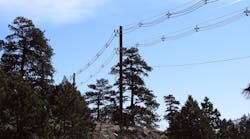Introduced into the United States in the 1800s as a landscaping plant, saltcedar (Tamarix ramosissima) has quickly grown into one of the Western states’ most dangerous and problematic invasive species.
A prodigious consumer of water, saltcedar can drink up to 200 gallons per day, leaving behind salty deposits that inhibit the growth of native vegetation. But it’s saltcedar’s growth, survival and reproductive capabilities that make it a true nightmare for vegetation managers.
First, while saltcedar typically reaches a maximum height of less than 30 feet, it can grow over 10 feet in a single season under good conditions, making early detection and treatment critical to effective control. Second, saltcedar can flower in its first year, can produce over 500,000 seeds annually and in the right environments can easily root from cuttings, allowing it to quickly overwhelm native species. It can rapidly resprout after fire, drought and flooding; seedlings have survived being submerged for over 60 days. Finally, saltcedar (like many other plants) can drop its thousands of evergreen-like leaves in response to stress, adding acres of fuel to areas already prone to fire.
Appearance and Distribution
With its long, slender branches and needle-like deciduous leaves, saltcedar gives the vague impression of an evergreen crossed with a willow. Its red or brown bark is fairly smooth, though the bark of older plants may be more textured. Pink or white flower clusters grow near the tops of branches.
While most common to Western and Southwestern states, saltcedar has been reported as far north as Massachusetts, as well as along the Southeast coast.
Saltcedar: Best Control Methods
Saltcedar’s ability to survive and regrow after cutting, flooding and even prescribed burning makes chemical control a critical component of any treatment program. Higher labeled rates of Garlon® 4 Ultra herbicide may be used as part of a broadcast, foliar or basal bark application to control saltcedar and other woody species. Cut-stump treatments using Garlon 4 Ultra herbicide either undiluted or as a 50% dilution v/v in water may be most effective against hard-to-control species like saltcedar. Applicators should always check the product label for appropriate usage rates, timing, tank-mix partners and application methods.
™ ® Trademarks of Corteva Agriscience and its affiliated companies. State restrictions on the sale and use of Garlon® 4 Ultra apply. Consult the label before purchase or use for full details. Always read and follow label directions. © 2023 Corteva.
Sponsored By:



